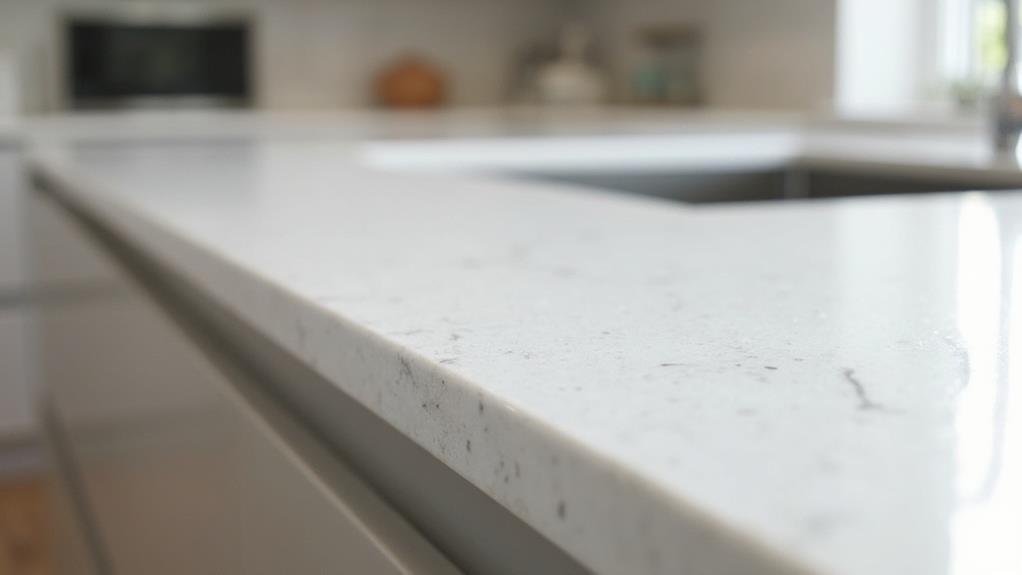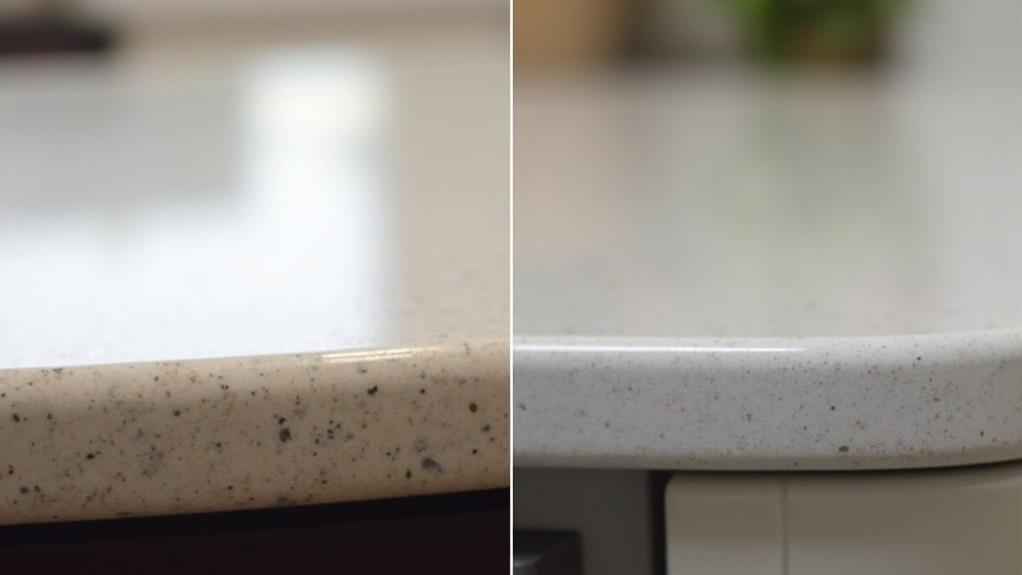When choosing a kitchen countertop edge profile, you'll encounter various options, each with unique pros and cons. Straight edges offer a clean, modern look that's easy to clean but can appear stark. Beveled edges add visual interest and deflect spills but may chip easily. Bullnose profiles provide safety and easy cleaning but can make spills more likely to drip. Ogee edges create a luxurious appearance but are harder to maintain. Waterfall edges make a bold statement but come at a higher cost. Your choice will impact your kitchen's aesthetics, functionality, and maintenance needs. Consider each option carefully to find the perfect fit for your space.
Straight Edge Profile

With its clean lines and minimalist aesthetic, the straight edge profile is one of the most popular choices for kitchen countertops. This simple design features a 90-degree angle where the top surface meets the edge, creating a crisp, modern look that complements various kitchen styles.
You'll find that straight edge profiles are easy to clean and maintain, as there are no curves or crevices where dirt and grime can accumulate. They're also less likely to chip or break compared to more elaborate edge designs. This durability makes them an excellent choice for high-traffic kitchens.
However, the sharp corners of a straight edge can be a safety concern, especially in households with young children. You might want to consider slightly rounded corners to mitigate this risk. Additionally, some homeowners find the straight edge too plain or austere for their taste.
Cost-wise, straight edge profiles are often more affordable than intricate designs, as they require less fabrication time. This can be a significant advantage if you're working with a tight budget or have extensive countertop areas to cover.
Beveled Edge Profile
In contrast to the straight edge, a beveled edge profile adds a touch of sophistication to your kitchen countertop. This design features an angled cut along the top edge, creating a sloped surface that catches the light and adds visual interest. You'll find that beveled edges come in various angles, typically ranging from 15 to 45 degrees.
One of the main advantages of a beveled edge is its ability to soften the appearance of thick countertops. It can make bulky materials like granite or quartz seem less imposing. Additionally, the angled surface helps to deflect spills away from cabinet doors, potentially reducing cleanup time.
However, there are some drawbacks to consider. The sloped edge can collect dust and crumbs more easily than a straight edge, requiring more frequent cleaning. It's also worth noting that beveled edges can be more prone to chipping, especially if the angle is particularly steep.
When choosing a beveled edge, you'll need to balance aesthetics with practicality. Consider the overall style of your kitchen and how the edge will complement your cabinetry and appliances. Remember that while a beveled edge can add elegance, it may not be the best choice for high-traffic kitchens or homes with young children.
Bullnose Edge Profile

The bullnose edge profile offers a softer alternative to the beveled edge. This rounded edge creates a smooth, gentle curve that wraps from the top of the countertop to the bottom. You'll find that it's a popular choice for many homeowners due to its versatility and timeless appeal.
One of the main advantages of the bullnose edge is its safety factor. The rounded profile eliminates sharp corners, making it an excellent option for households with children or elderly members. It's also easier to clean, as there are no crevices where dirt and grime can accumulate.
However, the bullnose edge isn't without its drawbacks. It can make your countertop appear thicker than it actually is, which mightn't be ideal if you're going for a sleek, modern look. Additionally, the rounded edge can cause spills to drip onto the floor or cabinet fronts more easily than straight-edged profiles.
When considering a bullnose edge, you'll need to decide between a full bullnose (completely rounded) or a half bullnose (rounded on top, flat on bottom). Your choice will depend on your aesthetic preferences and practical needs.
Ogee Edge Profile
Two distinct curves characterize the ogee edge profile, creating an elegant S-shaped contour. This traditional and ornate design adds a touch of sophistication to your kitchen countertops, making it a popular choice for homeowners seeking a luxurious look.
The ogee edge profile's intricate curves can make your countertops appear thicker and more substantial, enhancing the overall visual appeal of your kitchen. It works particularly well with natural stone materials like granite or marble, as it showcases their beauty and depth.
However, you should consider a few drawbacks before choosing this profile. The complex shape can make cleaning more challenging, as dust and debris may accumulate in the curves. It's also more prone to chipping due to its delicate edges, requiring extra care during daily use.
Additionally, the ogee edge profile tends to be more expensive than simpler options due to the craftsmanship involved in its creation. If you're on a tight budget, you might want to explore more cost-effective alternatives.
Despite these considerations, the ogee edge profile remains a timeless choice that can elevate your kitchen's aesthetic and add value to your home.
Waterfall Edge Profile

While the ogee edge profile offers classic elegance, modern kitchens often embrace a bolder look with the waterfall edge profile. This striking design features countertop material that seamlessly extends down the sides of cabinets or islands, creating a dramatic vertical drop that reaches the floor. It's a statement-making choice that can transform your kitchen into a contemporary showpiece.
The waterfall edge profile excels in creating a sleek, continuous appearance that draws the eye and adds visual interest to your space. It's particularly effective for showcasing luxurious materials like marble or exotic granites. You'll find it's easier to clean than traditional edges, as there are fewer nooks and crannies for dirt to accumulate.
However, this profile comes with some drawbacks. It's typically more expensive due to the additional material required and the complexity of installation. The vertical edges can be prone to chipping or damage from impact, especially in high-traffic areas. Additionally, the bold look may not suit all kitchen styles and could potentially overwhelm smaller spaces. Consider your budget, kitchen layout, and overall design aesthetic before committing to this eye-catching edge profile.
Conclusion
As you've explored these countertop edge profiles, you've likely found one that catches your eye. Coincidentally, the profile you're drawn to might be the same one your neighbor just installed. Remember, there's no perfect choice; each profile has its merits and drawbacks. Consider your lifestyle, budget, and personal taste when making your decision. Whatever you choose, you'll be adding a unique touch to your kitchen that'll serve you well for years to come.

